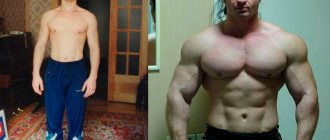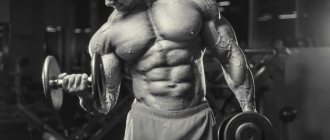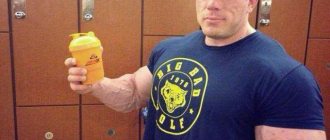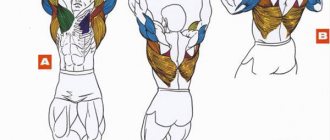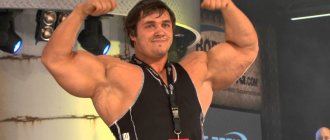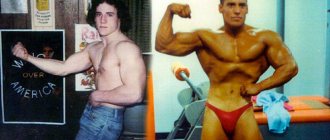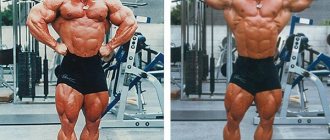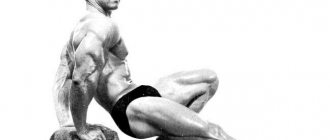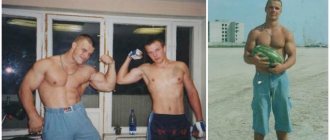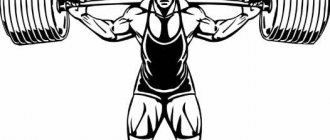In one of the previous articles, we examined the personality of such a well-known bodybuilder-blogger in RuNet as Alexey Schroeder. The article about him turned out to be quite popular among our readers. Therefore, this time we decided to write an article about another, no less famous bodybuilding blogger. So, meet Denis Borisov :
Denis Borisov: general information
According to the website sportwiki.to (https://sportwiki.to/Denis_Borisov), Denis Borisov was born in Minsk on September 14, 1980.
- Prize-winner of several bodybuilding competitions
- Has a higher legal education (Minsk Institute of Management)
He is one of the first bodybuilders (if not the first) who began to actively maintain and promote their websites, blogs and Youtube channels. The only person who can share the palm in this direction with him is the no less famous Yuri Spasokukotsky.
The official website of Denis Borisov is fit4life.ru. We do not know for sure when Denis began to actively develop this site, but, judging by the WHOIS service, the registration date of this domain is March 10, 2008.
We ourselves were subscribed to his Email newsletter (which has now moved to Telegram), and have been following his materials since approximately 2011-2013.
One of the important distinguishing features of Denis Borisov is that he does not hide the fact that he himself regularly took steroids (while many other bloggers try to deny or hush up this fact). Moreover, he has training courses on the use of steroids and other hormonal pharmacology (insulin, growth hormone).
Initially, Denis provided content only on the topic of fitness, healthy eating and bodybuilding, but gradually changed the topic of his materials to a broader one. Now in his videos he answers a wide variety of questions from subscribers, and also talks about finance, cryptocurrencies, relationships, psychology and much, much more.
Denis is also the author of a number of paid training courses. We'll talk about them a little later.
How to train for beginners
Denis believes that split training is greatly overrated, and for beginners he generally recommends full body training exclusively. The athlete recommends switching to split training only after a couple of years; until this point, fullbody training 3 times a week is suitable for those who are just starting to train.
— A common option for beginners is fullbody training 3 times a week, and the load should be distributed in a certain way. Let's say an approach to the legs, an approach to the back, an approach to the chest, an approach to the deltoids, an approach to the arms, and then you come back and do it all over again. There is no need to do each muscle group completely and only then move on to the next one; the correct option would be to alternate them with each other. Such a workout should last 30-60 minutes, says Borisov.
How much does Denis Borisov bench press?
Again, according to the site sportwiki.to, his strength indicators in some of the popular exercises are as follows:
- Incline bench press: 140-160 kg for 6 reps
- Standing chest press: 100-110 kg for 6 reps
- Bars: 50-60 kg for 10 reps
All this with a height of 178 cm and a weight of 98-110 kg.
It should be noted that his physical form in some photos and videos “floats” a lot. In old videos, he demonstrates very high-quality conditioning (large muscles, good relief, “clear” abs). However, in later videos, he tries not to show himself without clothes.
Apparently, at the moment his form leaves much to be desired, although this is not surprising for an athlete who has given up farming.
Release in audio (mp3) format:
You can find all episodes in audio format HERE
FEATURES OF THE “TURN-10” PROGRAM
- EXERCISES: BASIC
- INCREASING INTENSITY: STRETCHED SUPERSETS
- LOAD: PROGRESSIVE weight
- REPS: 10 (TEN)
BASIC EXERCISES are exercises that involve several (more than one) joints. Why is it important in the mass-gain cycle? Because such a load is more natural for our musculoskeletal system and involves more muscles than isolated exercises. This means you are stronger in these exercises. It is logical that the more muscles you work, the better for overall muscle development. In addition, the more muscles contract, the greater the load you can handle. And this directly affects the central nervous system (brain-muscle connection). Those. in basic exercises the level of nervous stimulation of muscle contractions is more powerful. Which leads to better growth of large muscles.
STRETCHED SUPERSETS (ALTERNATING) - essentially we are talking about supersets WITH REST. Traditionally, a SUPERSET is TWO exercises performed on ANTAGONIST MUSCLES, one after the other, without rest.
What are antagonist muscles? ANTAGONIST MUSCLES are muscles with opposite functions. Those. if, for example, one muscle performs flexion in a joint (biceps), and the other performs extension in this joint (triceps), then these muscles will be antagonists.
For example, if you do a set of biceps curls and immediately do a set of French presses for triceps without rest, then this is a SUPERSET. If you do two exercises for the same muscle without rest, for example, barbell curls and barbell curls, then this is a COMPLEX SET (not a superset). If you rest between sets of antagonist muscles, for example, you did a set of biceps curls and rested for 30-60 seconds before doing triceps presses, then this is a STRETCHED SUPERSET. That's what we will do in this program. A STRETCHED SUPERSET takes longer (stretches out time), due to additional rest during ALTERNATING exercises.
MAIN ANTAGONIST MUSCLES:
- CHEST-BACK
- BICEPS-TRICEPS
- QUADRICEPS-BICEPS TEMORAL
- PRESS - BACK EXTENSORS
- FRONT DELTA - BACK
- REAR DELTOUS - CHEST
SUPERSET example:
- Barbell curl for biceps 5 X 10
- French Bench Press 5 X 10
PROGRESSION OF LOAD is the fundamental principle of any speed-strength sport where muscles are involved. Only the progression of load on your muscles forces them to progress in size and strength. If the load does not increase, then your muscles have no reason to increase either. Everything is very simple. To implement LOAD PROGRESSION, it is vital to keep a DIARY. The goal of which is to systematically increase the load from training to training. We increase the load in this program by increasing the training weights in basic exercises from one week to the next.
NUMBER OF REPEATS i.e. how long will your muscle be under load. Typically, the lower the reps, the more weight you can lift and the less the muscle is depleted under load and vice versa. For increasing muscle size, this is not a good idea because the energy depletion is not as profound as if you lifted a lighter weight and did more reps. The fact is that it is the depletion of energy reserves during muscle work that causes their microtraumas, which subsequently leads to healing and growth (compensation and supercompensation).
6 to 12 is the traditional rep range in bodybuilding. It is these “gates” that allow you to deeply deplete the muscles by combining a fairly heavy weight + quite a lot of repetitions. You can debate for a long time what exact number of repetitions will work best, but this is useless, due to the individual characteristics of each person (his fitness, genetics and speed of repetitions). Therefore, I decided not to burden you but to take the classic number of repetitions equal to TEN (10 repetitions per set). In my opinion, during the bulking phase, this amount works very well for most people (even those who previously only worked 6 reps).
THE MAIN ESSENCE OF THE PROGRAM IS ALTERNATING EXERCISES ON ANTAGONIST MUSCLES WITH REST BETWEEN THEM + 10 REPS PER APPROACH.
HOW WELL DOES THIS ALTERNATING WORK? Very good. In my opinion this works better than traditional linear training. Extended supersets (alternating) have a couple of major advantages over traditional training methods:
- MUSCLES RECOVER FASTER BETWEEN APPROACHES
- MUSCLES ARE BETTER SUPPLIED WITH NUTRIENTS
MUSCLES RECOVER FASTER BETWEEN APPROACHES when you train the antagonist muscle. Scientists have long known that active recovery in sports (when you do not sit or lie, but walk or do light exercise) is more beneficial than passive recovery. When applied to bodybuilding, it turns out that by performing a heavy work approach on another muscle, your main muscle receives light stimulation, thanks to which it recovers faster. In practice, this leads to the fact that your muscles are faster ready for new approaches, which means you can perform more of them during the workout.
MUSCLES ARE BETTER SUPPLIED WITH NUTRIENTS during antagonist training. In fact, if you stop working, the blood gradually begins to drain from the working muscle (blood is the carrier of all nutrients from oxygen to amino acids and hormones). But the blood cannot escape if stimulation of the antagonist muscle continues. It turns out that the sheep are safe and the wolves are well-fed. The muscles rest and at the same time continue to be supplied with nutrients as during work.
HOW MUCH TO REST BETWEEN APPROACHES
You will need much less total rest time than usual because you will be alternating opposing muscles during the workout. As we already understood, in such a situation, muscles, firstly, recover faster. And secondly, the muscles receive additional active rest while you train the antagonist. In total, this allows you to reduce the rest between all approaches.
- FOR LARGE MUSCLES you will most likely need 60 seconds of rest between antagonists
- FOR SMALL MUSCLES you will most likely need 30 seconds of rest between antagonists.
Why is there such a difference in rest? If you train large groups, such as BACK, CHEST, LEGS, then load not only the target muscles, but also the rest (arms, deltoids, etc.) i.e. systemically, all these muscles require more rest to recover than when training small muscles.
It is permissible to reduce the rest between approaches to the antagonist muscles, but add it after completing the “two” approaches. I advise you not to be rigidly attached to any specific time (30 or 60 seconds, as in my example). Listen to how you feel. You may need more rest. Personally, when working small muscles (such as biceps and triceps), I rest for 30 seconds. It looks something like this:
- Biceps curl = 20 seconds
- Rest 30 seconds
- Triceps set = 20 seconds
- Rest = 30 seconds
- Biceps curl = 20 seconds
- Rest 30 seconds
- Triceps set = 20 seconds
- Rest = 30 seconds
- etc…..
TRAINING SPLIT “ROLL-10”
- CHEST - REAR DELTA
- BACK - FRONT DELTA
- BICEPS - TRICEPS
- LEGS (quadriceps - hamstrings)
Not quite the usual split by day for most athletes. Usually the classic antagonists CHEST (push) - BACK (pull) are combined in one training session. However, I don’t like this idea during the bulking phase due to the overload of the workout with two large muscle groups. I allow this arrangement in the fat burning phase. In my opinion, if you train two large muscle groups in one workout, this can reduce the effectiveness of working each of them separately due to lack of strength and energy. In addition, with such a layout the deltas would have to be placed somewhere:
- CHEST-BACK
- BICEPS-TRICEPS
- LEGS
- DELTA
They would have to be done on a separate day (which is too fatty for such a small group), or combined with legs or other muscles (this would reduce the effectiveness of training both these other muscles and the deltoids themselves). Therefore, I use a more elegant solution - I DIVIDE THE DELTA TRAINING INTO TWO DAYS. This decision is logical because DELTA performs both PULLING functions (back) and PUSHING functions (front). It is quite logical to train the PULLING DELTOUS (rear) with stretched supersets with a PUSHING CHEST, and train the PUSHING DELTOUS (front) with a PUSHING BACK.
This allows us to more EQUALLY distribute strength and resources to train all the major muscles of our body. HOW TO DISTRIBUTE WORKOUTS BY DAY OF THE WEEK? It depends on your work/study schedule and fitness level. As a guide, I recommend training a MUSCLE GROUP ONCE A WEEK i.e. the indicated four training days must be distributed among SEVEN days of the week. There are possible options here. Personally, I use this most often:
- Mon. CHEST + HI. DELTA
- Tue. BACK + FRONT DELTA
- Wed.
- Thurs. BICEPS + TRICEPS
- Fri. LEGS
- Sat.
- Sun.
or this:
- Mon. CHEST + HI. DELTA
- Tue
- Wed. BACK + FRONT DELTA
- Thurs.
- Fri. BICEPS + TRICEPS
- Sat. LEGS
- Sun.
Each has its pros and cons. The first distribution leaves completely free weekends (Sat and Sun). This gives you the opportunity not only to have fun with your girlfriends, but to recover better due to two full days of rest. In the second distribution, after each large muscle group you have a rest day. In any case, I advise you to listen to your feelings and look at your work schedule, when arranging it by day of the week.
EXERCISES IN THE “TURN-10” PROGRAM
CHEST, REAR DELTA
- lying crunches 5 X max.
- Incline press pcs. lying down 3 warm-ups + 5 X 10
- Barbell row to the chin 3 warm-up. + 5 X 10
- Dumbbell bench press 1 warm-up. + 5 X 10
- Standing dumbbell swings 1 warm-up. + 5 X 10
- Lying dumbbell flyes 1 warm-up. + 5 X 10
- Bent-over dumbbell swings 1 warm-up + 5 X 10
BACK, FRONT DELTS
- Reverse crunches 5 X max.
- T-bar row 3 warm-up. + 5 X 10
- Standing chest press 3rd warm-up. + 5 X 10
- Vertical row from above 1 warm-up. + 5 X 10
- seated dumbbell press 1 warm-up. + 5 X 10
- One arm row 1 warm up. + 5 X 10
- Swing a dumbbell in front of you 1 warm-up + 5 X 10
BICEPS, TRICEPS
- Lying crunches 5 X max.
- Barbell curl for biceps 3rd warm-up. + 4 X 10
- Close-grip bench press 3 warm-ups. + 4 X 10
- Standing hammer curls 1 warm-up. + 4 X 10
- French from behind the head 1 warm-up. + 4 X 10
- Bends on the upper block 1 warm-up. + 4 X 10
- Extensions on the upper block 1 warm-up + 4 X 10
LEGS, CALVES
- reverse crunches 5 X max.
- Standing calves 2 warm-ups. + 5 X 10
- Squats with a barbell 3 warm-up. + 5 X 10
- Lying leg curls 3 warm-ups. + 5 X 10
- Leg press 1 warm-up. + 5 X 10
- Leg curls standing (or sitting) 1 warm-up + 5 X 10
- Deadlift on straight lines 1 warm-up. + 5 X 10
- Seated leg extension 1 warm-up. + 5 X 10
Links to websites and social networks of Denis Borisov
- Website fit4ru – fit4life.ru
- VK profile - https://vk.com/id8315063
- Instagram profile - https://www.instagram.com/den_borisov_official/
- YouTube channel (“Fit4Life”) - https://www.youtube.com/channel/UCgGMKF6EFWrB0agBBPt2V3w (at the time of writing, the channel has 649 thousand subscribers)
- YouTube channel (“Money 2.0”) - https://www.youtube.com/channel/UCnvtYPrCPIKx5sXe4_pwD5Q (at the time of writing, the channel has 269 thousand subscribers)
- Telegram channel - https://t.me/Fit4LifeRu
Training courses by Denis Borisov
In terms of creating training courses, Denis turned out to be very fruitful. Over the course of several years, he released about 20+ paid materials. Here are some of them (the list may not be complete):
- Vnature: How to get pumped up without steroids
- V3 - Volume Progress (2013)
- Sportpit with garlic
- Algorithm for choosing your training program (2012)
- Anabolicum (2013 and 2015)
- Antichemist (2013)
- Anabolicum 2 Bread and Butter
- Hyperplasia (2012)
- How to pump up crisp abs at home (2012)
- The Bodybuilder's Catechism (2012)
- Summer Scheme (2015)
- Male Circuit (2013)
- Statodynamic workshop (2015)
- Harsh Fat Burner (2014)
- Body drying “Rocket”
- Body Under Reconstruction (Volume 1 - Laying the Foundations) (2013)
- Carcass to dry (2013)
- Epic hands from Denchik
- Jock-action guy
Also, he has materials not only on the topic of strength training:
- Internet bubblerub
- Investor's Bible
- Biohacker
- Life 120
We had the honor of familiarizing ourselves with many of his materials, and we are ready to assert that they are of sufficient quality, interesting, and quite worthy of attention.
LOSSES INEVITABLE?
First of all, we must understand that our body always STRIVES FOR EQUILIBRIUM (HOMEOSTASIS) , because it is beneficial for it (less energy is wasted). When you drive your body into a “minus” by training, it reacts by accelerating protein synthesis in order to create a commensurate “plus” to maintain BALANCE. This “plus” is the GROWTH OF YOUR MUSCLES.
- If there is a “minus”, but there is no “plus” , then this is not beneficial, because the body damaged by training will spend more energy.
- If there were only a “plus” without a “minus” , then it would not be beneficial to the body, because large muscles (“pluses”) require large energy expenditures unnecessarily (without training).
Do you understand how logical and balanced everything is in our body? When you go on a business trip or vacation, where there is no opportunity to “drive your body into its usual negative state,” your muscles begin to dry out because they become unprofitable : there is no load, and a lot of energy is spent on their maintenance.
But this happens almost always. For example, at home you are used to bench-pressing a 120 kg barbell and 35 kg dumbbells to train your pectoral muscles... And suddenly everything has changed! You have moved to a new place where there are no dumbbells or barbells. What does it mean? This means that you will not be able to give the body the usual heavy load and it will become unprofitable for it to maintain the large pectoral muscles in such conditions. What will it start to do? Right. The muscles will begin to lose weight! CONCLUSION: If the training load is reduced upon departure, then losses are inevitable.
